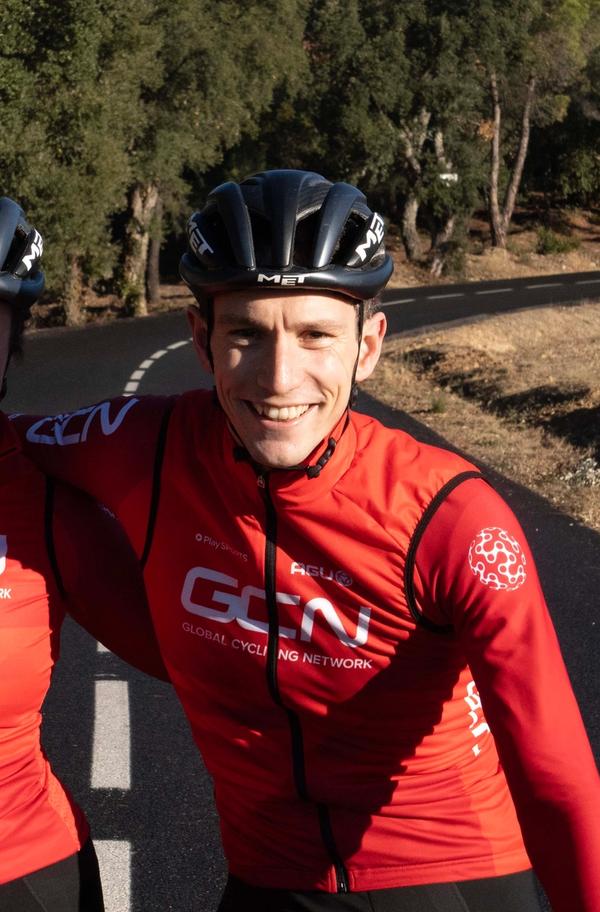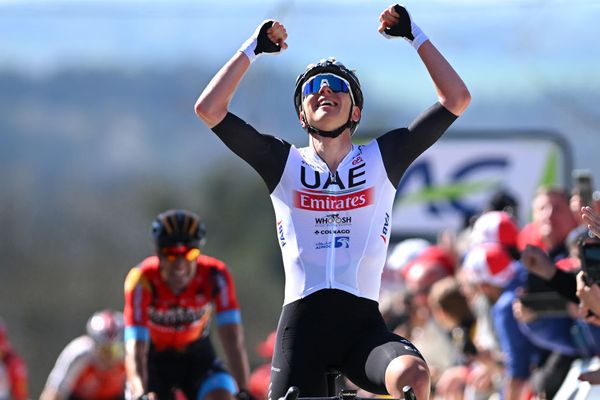Iñigo San Millán: From the Tour de France to cancer research
Tadej Pogačar's coach and pioneer of polarised training is leading the way in cancer research, and using insights from professional cyclists to do it
James Howell-Jones
Junior Writer
Iñigo San Millán’s work in cycling is well known. He’s the coach of Tadej Pogačar, the head of performance at UAE Team Emirates, and he has transformed the way we think about training through his pioneering polarised training approach. Less well known, though, is his work in cancer research. San Millán is part of a team exploring the link between metabolism and cancer, and he believes this avenue of research could lead to a breakthrough in the way we fight cancer.
GCN’s Simon Richardson caught up with San Millán at the Tour de France to hear about his research, and to hear about the way that he is using his pro cyclists to get a better understanding of how cells work, and how our bodies respond to cancerous cells. You can watch the full interview in the video above, but for the key insights, read on.
San Millán’s involvement in cancer research
For the past 16 years, Iñigo San Millán has been researching metabolic systems – the processes that our cells use to turn sugars into energy. Seven years ago he turned his attention to cancer, when he realised that his expertise in metabolism could be applied to cancer research.
San Millán’s research picks up from where 20th century scientist Otto Warburg left off. In 1923, Warburg discovered that normal cells undergo changes as they become cancerous; they utilise a lot of glucose and produce a lot of lactate. Warburg posited that cancer was a metabolic disease – a disease that disrupts the normal process of converting food to energy on a cellular level.
Warburg’s findings were lauded, until in 1953, when James Watson and Francis Crick discovered DNA, and everything in the field of cancer research changed. With a new awareness of DNA, the scientific community believed that they could cure the disease by altering or blocking genes. San Millán spoke of how “we were told, ‘yeah we're going to turn off a gene, and we're going to cure cancer'. That has never happened.”
Warburg’s findings were buried under the new genealogical approach. Until the turn of the century, says San Millán, Warburg had “absolutely no citations in the scientific literature".
As more and more genealogical research reached a dead end, and as our understanding of metabolism advanced in the 21st century, Warburg’s findings regained prominence in the scientific community. Now, says San Millán, “almost every single cancer research paper, either in the abstract or the introduction, already talks about the Warburg Effect".
San Millán’s doctoral thesis was about metabolism and muscle physiology. When he learnt of the Warburg Effect, he realised his expertise was highly relevant to this area of research. He had spent years studying the systems, processes and “pathways” that go on in our cells, and was well-placed to observe flaws and dysregulations in cancerous cells.
The role of San Millán’s elite athletes
San Millán stressed the role his elite athletes have played in his research. As he puts it, "we cannot understand imperfection if we don’t know perfection in the first place". The athletes he works with are, in San Millán’s eyes, “perfection” – they are “the best machines on the planet". As a result, they can hold insights at a metabolic level. Scientists can observe how their cells work and how their metabolisms work, without having to account for the inefficiencies, flaws or lifestyle factors that would be present in anyone other than top-level, elite athletes.
“If it wasn't for the lessons learned from elite athletes, at least for me, it wouldn't have been possible to understand the dysregulations happening in cancer.”
With a full understanding of metabolism, the researchers could achieve a couple of things. Firstly, they could identify cancerous, dysregulated pathways within cells by comparing them to the “perfect” metabolic processes they’ve studied in athletes. Secondly, they could start to target those pathways.
Identifying and targeting cancerous cells
San Millán told GCN: “One thing that we know, and and this is what struck Warburg a hundred years ago, was [...] that the cancer cells, they use a lot of glucose, but they produce a lot of lactate – this is now, by the way, why a lot of people are talking about sugar and cancer.” This process, now widely known, is called the Warburg Effect.
Lactate is really important. It’s produced by cancerous cells, but it’s also produced when we exercise. “It's a key signalling molecule for cellular health and homeostasis, and also for improving functions at the cellular level and even mitochondrial function as well.” When we’re exercising, producing lactate is good: “It’s very important for the brain; it’s great fuel for the body – it's the best fuel, probably, for the body.” Crucially though, when we exercise, that lactate is cleared. “In the case of cancer, that lactate is never cleared; it keeps building up.”
“What we know, and we have discovered, and we have proven, is – and we have a series of papers that we're going to be publishing in the next months or a year – that the excessive lactate that is not clearing [...] is deleterious and detrimental for the cell, and it's a key player in in the cancer process, in what's called carcinogenesis.”
Having established the detrimental effect of lactate buildup, San Millán and his peers can begin to find ways to limit lactate production in cancer cells.
“We can, for example, block one enzyme that produces lactate in the body, specifically in cancer cells, and when we block it there's no lactic production in these cancer cells, so those cancer cells don't express their genes and their proteins, and those cells eventually die – they don't grow.”
San Millán is even hoping to reverse the metabolic reprogramming that leads to the Warburg Effect in the first place: “What we can do with this pathway, by targeting, is to reverse that metabolic reprogramming back to a normal reprogramming. The problem is like those cells are mutated in those cancer cells, and they don't like that. So eventually, the cancer doesn't know what to do, and eventually cannot thrive, and dies.”
A nano-particle that can intervene with cancerous cells
With his team, San Millán has developed a first prototype of a nano-particle that can detect cancer. “The nanoparticles are about the size of a virus – extremely small: about 1,000 times smaller than the diameter of hair, and you can inject thousands into the body, and then you can load them with medications.”
But they need to be able to target cancer cells, otherwise they’ll kill any cell in the body. “We have a first prototype of a nanoparticle which can recognise a cancer cell, and then the next level is to fine-tune that nanoparticle, and then load it with medication that penetrates the cancer cell.”
It’s early days, but San Millán is optimistic
San Millán’s cancer research is still in an early phase, and is a long way off being accessible to cancer patients. They might have their first prototype, but years of testing lie ahead, and with each stage, the costs continue to rise. We are always fighting for funds, so it’s very difficult to continue," he said.
Nonetheless, San Millán thinks that, eventually, this course of research is going to lead to a cure. He told us: “I'm not going to cure cancer of course, but at least we open new doors, right? And that's the whole role of all of us contributing. Once you open the door, or others open the door, you keep entering or keep opening doors and doors and doors.”
“We're very optimistic that this [...] could be the last step to finally conquer cancer.”












